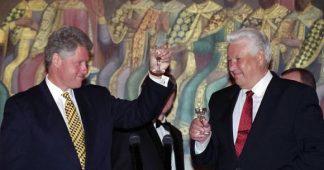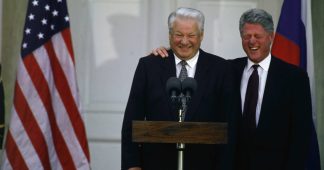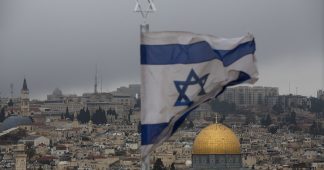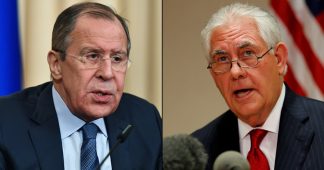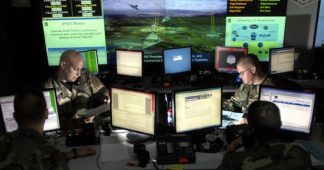Declassified Clinton-Yeltsin Telcons Show U.S. Support No Matter What
Embassy Cables and Oral Histories Detail Complex Conflict and U.S. Motivations
Today’s Russian Opposition Sees Crucial Turning Point Towards Today’s Autocracy
by Svetlana Savranskaya and Tom Blanton
Oct 4, 2018
Washington, D.C., October 4, 2018 – Twenty-five years ago last night in Moscow, Russian President Boris Yeltsin ordered tanks and airborne troops to shell and storm the “White House,” the Russian Parliament (Supreme Soviet) building, to suppress the opposition trying to remove him.
Declassified documents published today by the National Security Archive include the transcript of U.S. President Bill Clinton’s phone call to Yeltsin the next day to praise him, the memcon in which U.S. Secretary of State Warren Christopher subsequently told Yeltsin this was “superb handling,” and two State Department cables painting a more complex portrait of the causes of the events.
The Web posting also includes two oral history accounts, one from then-Russian Defense Minister General Pavel Grachev about his specific role, including his orders to fire the tank cannon that set off a “beautiful fire” in the White House, and the other from U.S. Ambassador Thomas Pickering who believed the U.S. had “no choice” but to support Yeltsin.
Marking the 25th anniversary, Russian media such as Gazeta.Ru and leading independent newspaper Novaya Gazeta have published multiple interviews and historic photos and video footage of the events, but no new Russian documents. Novaya Gazeta argues that October 1993 was the crucial turning point towards today’s autocracy.
* * * * *
A Quarter Century after the Storming of the Russian White House
By Svetlana Savranskaya
25 years ago today in Moscow, President Boris Yeltsin resolved his standoff with the Supreme Soviet of the Russian Federation by storming the White House, which resulted in numerous casualties, but even more importantly, in the loss of faith in democracy and in the overwhelming preponderance of executive power in Russia ever since.
New documents published today by the National Security Archive provide a glimpse into how the situation was viewed from Washington and from the Kremlin. At the time, from these two vantage points, the picture was black and white—democratic and free market reformers on Yeltsin’s side and a communist and fascist opposition trying to force the country back into its totalitarian past. Since power in Russia never changed hands other than by way of transfer to a chosen successor, full public examination of evidence of the events of 1993 never took place. However limited, the selection of documents published today shed new light on the complexity of the events and the high stakes the Clinton administration saw in Russia in the fall of 1993.
The events of September-October 1993 are the subject of extensive coverage and intense controversy in Russia today as citizens re-examine those experiences. Gazeta.ru devoted significant space to in-depth interviews and analysis of the events of the constitutional crisis over the last two weeks including a detailed chronology of its final days with historic photos and video material. Unfortunately, no Russian documents on the events of 1993 are available in the archives yet. Novaya Gazeta today republished its issue of October 6, 1993, which gave comprehensive contemporaneous coverage and put blame on both sides for the first significant bloodshed in Moscow since the October revolution of 1917.[1] According to columnist Boris Vishnevsky, “after the fall of 1993, a practically unlimited autocracy triumphed in Russia.”
By the time the Clinton administration came to office in January 1993, the momentum of Russian reform was on the decline. Faced with severe consequences of market reform coupled with the effects of disintegration of economic ties after the dissolution of the USSR and the absence of any meaningful foreign economic assistance, Russia’s population and political elites began questioning the pace of the reform and the forceful methods of its implementation. The team of young reformers that Yeltsin appointed in late 1991 was decimated under the pressure from the Supreme Soviet, and Yeltsin had to replace Acting Prime Minister Yegor Gaidar with Victor Chernomyrdin in late 1992.
Rather than negotiating with the Parliament, Yeltsin habitually ruled by issuing Presidential Decrees. The opposition led by Vice President Alexander Rutskoy and Chairman of the Supreme Soviet Ruslan Khasbulatov was growing in the Parliament and in the regions, and blocking most of the president’s initiatives, which led to a paralysis of governing. The incoming U.S. administration started its dialog with Russia in a state of virtual civil war between the executive and the legislature.
The declassified telcons and memcons of early Clinton-Yeltsin conversations show instant chemistry between the two leaders, genuine warmth and optimism and an incredibly rich agenda on which Russia and the United States agreed to cooperate (Document 2. See also EBB 640). Clinton mostly set the agenda, while Yeltsin, eager to build a genuine partnership with America, enthusiastically agreed to work together with him. Clinton was deeply committed to Russia’s transformation into a democracy and market economy as well as to its full integration into the Western world. Another top U.S. priority was to safely manage the post-Soviet re-gathering of nuclear arsenal back to Russia and to help it to dismantle and secure weapons and fissile materials, which was accomplished in the framework of the Nunn-Lugar programs (See EBBs 447, 528 ).
Given this setting, Yeltsin, with his resume of a democratically elected Russian leader and a defender of democracy during the coup of 1991, seemed like an ideal partner who could deliver on all U.S. priorities. According to Strobe Talbott, some of Clinton’s advisers were concerned about Yeltsin’s unwillingness to consult and compromise with the Parliament and advised Clinton to focus on “principles and process,” not personalities. The president, however, was committed to Yeltsin as a personification of the revolutionary change and responded that this was “a zero-sum” thing.[2] This perception only intensified during Yeltsin’s final showdown with the Supreme Soviet in the final days of September 1993.
According to Ambassador Thomas Pickering, Yeltsin sent Foreign Minister Andrei Kozyrev to notify four key Western ambassadors about his intention to dissolve the Parliament and call for new elections (Document 4). In Clinton’s first phone call to Yeltsin immediately after the latter issued Decree 1400, dissolving Parliament and setting a date for early elections and a constitutional referendum, the U.S. president expressed his full support and accepted Yeltsin’s assurances that there would be no bloodshed and the reform would move faster now that there would be no obstacles. U.S. support for Yeltsin remained unwavering all through the confrontation and after the Russian President issued the order to storm the parliament (after initial violence on the part of the opposition).
On the morning of October 4, Muscovites awakened to the awful sight of the burning Parliament building—the White House they had defended against the putsch in August 1991, where Yeltsin had stood on a tank and led the democratic forces. On October 5, the day after the bloodshed, Clinton called Yeltsin and congratulated him for his handling of the situation; he did not ask about the loss of life. Even stronger support was expressed by Secretary of State Warren Christopher, while visiting in mid-October, who practically lauded Yeltsin for his actions during the crisis. Documents show that the Clinton administration saw no alternatives to Yeltsin and was prepared to support him no matter what.
This situation grew out of the extreme personification of U.S.-Russia policy but also from the black-and-white picture the Yeltsin camp presented of the political situation in Russia, painting his opponents as “fascists” and unreformed communists. In fact, it was the same Supreme Soviet that was elected in the lauded free elections of 1990, that elected Yeltsin its chairman, and that granted him emergency powers to implement the radical economic reform in October 1991. As the year 1993 progressed and the political confrontation in Russia deepened, the U.S. administration dealt exclusively with the Yeltsin camp and came to regard the opposition as their Russian interlocutors presented them. But most importantly, the stakes were very high: Yeltsin was a good partner who was willing to play on U.S. terms, and any alternative—even democratically elected—was deemed unlikely to be as cooperative or reliable. The Clinton administration was therefore highly invested in Yeltsin and, as Ambassador Pickering says he told Strobe Talbott, “you’ve got no other choice” than to support Yeltsin and hope that the December elections would be free and fair.
Not all actors on the U.S. side shared that opinion. Chargé d’Affaires James Collins’ cables show a more nuanced reading of the crisis and a deep concern about the fairness of the elections and the authoritarian potential of Yeltsin’s new Constitution, which Collins calls “half-baked.” (Document 7). The Pickering oral history also points to differences of opinion within the Embassy (Document 4). These disagreements did not seem to affect Clinton’s consistent support for Yeltsin’s handling of the opposition. U.S. backing remained constant after the disastrous election results in which Yeltsin’s party received only 15 percent of the vote and the Constitution barely passed the referendum. The system that emerged was essentially super-presidential, which did not worry most senior U.S. officials as long as a true democrat, in their view, held the post of president.
The last document in today’s published selection is an excerpt of an oral history interview with Yeltsin’s Defense Minister Pavel Grachev conducted by Petr Aven and Alfred Kokh (Document 12). Grachev’s account of events provides a graphic picture of how the Yeltsin camp viewed the opposition and their methods of dealing with it. It also gives great insight into the complexity of the situation and the role of the armed forces.
The Clinton administration at the time saw Yeltsin as the guarantor of Russia’s democratic transition and thus viewed the outcome of the crisis as a victory for democratic forces, however unfortunate the loss of life was. Many Russian democrats, however, considered the events of 1993 as the turning point from democracy to an increasingly paternalistic and autocratic rule by Yeltsin and his successor. Twenty-five years later, the controversy over the constitutional crisis of 1993 is not over and final judgments will have to await, among other things, the declassification of top-level Russian documents.
Read the documents
This is a copy of a cable containing the memcon between Yeltsin and Clinton with a cover note from Secretary of State Warren Christopher to Strobe Talbott instructing him to review the memcon before his forthcoming meeting with Russian Deputy Foreign Minister Georgy Mamedov. In the handwritten notes he also records his impressions from the meeting. He is “struck by […] B[ill] C[linton]’s command of the issues […] his dominance in [meeting] (hard to do with Yeltsin), and “no rhetoric or posturing on either side.”
This memcon is important because it shows the impressive variety of issues on which Clinton and Yeltsin had a productive exchange and agreed to cooperate: replacing COCOM with a new regime; a deal on highly enriched uranium (HEU) that Russia was going to remove from the nuclear warheads being withdrawn from Kazakhstan; Ukraine and Belarus and partly return to Ukraine as fuel for nuclear power stations and partly sell to the United States in the framework of the Megatons for Megawatts program; working with Ukraine to return the nuclear weapons to Russia; progress on CTBT; non-proliferation, and specifically limiting Russia’s sales of reactors, missiles, and submarines to Iran and India; getting North Korea to the negotiating table; peacekeeping in Georgia and Nagorny Karabakh; and the withdrawal of Russian troops from the Baltics.
On the latter, Yeltsin made an official request that the U.S. side conduct an investigation of the laws in Estonia to determine if they discriminate against ethnic Russians (Christopher in his cover note recommends giving Yeltsin a proper legal response even if it is negative). The breadth of issues helps one understand that Yeltsin truly was an indispensable partner for Clinton across the range of U.S. priorities in the former Soviet Union and even globally. Only once is there a signal that Yeltsin is in a complicated place domestically. Mentioning that the Supreme Soviet has just passed a bill declaring Sevastopol a Russian city, Yeltsin says, characteristically, “Thank God no one takes the Supreme Soviet seriously!”
Chargé d’Affaires and future Ambassador to Russia James Collins sends Secretary Christopher a briefing cable in advance of his visit to Moscow where he is expected to meet with Yeltsin and other government officials. This is the first visit of any Western senior official to Moscow after Yeltsin’s dissolution of the Parliament and the October 3-4 bloodshed in the center of Moscow. In the cable, Collins describes the pre-electoral landscape in Russia on the eve of Christopher’s visit. Although 92 parties are registered for the election, that in itself does not guarantee free and fair elections.
The cable describes Yeltsin’s decision to push through the new “half-baked” Constitution, which concentrates the “preponderance of authority in the hands of the chief executive.” Collins points out that “even many reformers worry about establishing a new Russian democracy so heavily tilted toward presidential power.” The cable describes the split within the reformist camp into “radical” and “cautious” reformers, the confusion at the regional levels regarding whether the elections would be held for regional legislatures, and the continuing ban on nationalist and right-wing parties and their newspapers.
Collins notes the personal nature of the confrontation: “Boris Yeltsin’s face during his October 6 speech was proof the Russian President had cast his hardline opponents into a personal anathema.” He also raises concern about the methods used by Moscow police and city government in implementing the state of emergency, such as “systematic police cleansing of non-Russian people from Central Asian and Caucasian states,” and racist remarks about dark-skinned people by Moscow Mayor Yuri Luzhkov. In the end of the cable, Collins cautions that although the actual voting is likely to be fair, “the question will be the democratic content of the entire electoral process.”
In the follow-up to the previous cable (Document 6), Chargé d’Affaires Collins reviews foreign policy issues Christopher is expected to cover in Moscow in his meetings with Yeltsin and Kozyrev and emphasizes that Yeltsin is looking for gestures of support from the United States. New elections are scheduled for December and Yeltsin needs all the support from the West he can get. Collins advises the secretary of state to be sensitive to Yeltsin’s and Kozyrev’s need for Russia to be seen domestically as a partner with whom the West consults and does not just take for granted, and he lists some controversial issues: NATO expansion, the post-Soviet space, and Ukraine.
On NATO, Collins notes that the Russians are aware that the U.S. internal debate is reaching a crucial moment about expansion and they want to be assured that the door is open to Russia, not just to East Europeans. In Collins’ view, “what the Russians hope to hear from you is that NATO is not moving precipitously and that any policy NATO adopts will apply equally to them.” Their “neuralgic” attitude stems from the fear that they will “end up on the wrong side of a new division of Europe.” Therefore, Collins counsels Christopher to make sure the Russians know that the U.S. is actively promoting Russia’s “complete reintegration into the family of Western states.”
On his trip to Europe to explain the U.S. position on NATO expansion, Secretary Christopher comes to Moscow after meetings in Budapest. He and special ambassador Strobe Talbott meet with Foreign Minister Kozyrev and his deputy, Yuri Mamedov, before they visit Yeltsin at his country residence. Christopher raises concerns about the fairness of the upcoming elections with his Russian counterparts. He mentions that the United States has $12 million to contribute and is willing to send monitors or observers, which Kozyrev welcomes, saying they might help to guard against fraud by communist-leaning local authorities in rural areas where “the old kolkhoz mentality” still prevails. Christopher puts special emphasis on ensuring a free press since the order banning opposition newspapers was still not lifted. Kozyrev does not have a definitive answer to the question regarding banned newspapers and he says only six or seven political organizations will be banned from participating in the elections.
In this memo about the Kozyrev meeting, Christopher is very brief about the NATO discussion. He tells Kozyrev that the U.S. is sensitive to the Russian position and has developed a new proposal as a result: the Partnership for Peace (PFP), which would be open to all countries on an equal basis. Christopher does not directly address Kozyrev’s concern about the decision regarding expansion, but, misleadingly, lets it sound as if PFP is the alternative for the time being.
The rest of the conversation deals with crucial issues on which the United States needs Russian cooperation, such as support for Eduard Shevardnadze in Georgia and the withdrawal of nuclear weapons from Ukraine.
Christopher is taken to Yeltsin’s country house, Zavidovo, for a meeting that lasts only 45 minutes. Yeltsin has most likely already been briefed by Kozyrev about his conversation with the secretary of state. In the beginning of the conversation, Yeltsin reviews the events of September 21-October 4 in Moscow and expresses “special appreciation to President Clinton and Secretary Christopher for their early and very supportive backing. The Russian president talks about the upcoming elections, which he calls “the first free and fair election for the parliament since 1917,” and assures Christopher that the country has calmed down after the crisis. Yeltsin praises the new Constitution that is “up to the standards of the best Western democracies,” which would allow them to “end the old totalitarian regime with the power assigned to the soviets.” He also welcomes the Clinton visit to Moscow planned for January 1994.
Christopher starts with strong praise for Yeltsin’s handling of the constitutional crisis with the Parliament, passing on “high appreciation” and emphasizing that Clinton is “extremely supportive” of his “superb handling of the crisis.” According to Christopher, Clinton “admired the restraint” that Yeltsin has practiced since September 21 and that in the end he acted in a way that “caused the least loss of life.” He adds that “on Sunday October 3, the President also closely followed events and wanted to tell President Yeltsin that […] our thoughts were with you in Moscow all day.” Christopher offers technical assistance for the election and notes that “there are already numbers of our experts here who could be helpful but we would like to assist in any way in which we could do so.” Essentially, Christopher lauds Yeltsin’s handling of the crisis and never raises any concerns mentioned in Collins’ cable (see Document 6, above) about irregularities in the electoral process or the nature of Yeltsin’s constitution.
At the end of the conversation they briefly touch on the sensitive question of NATO expansion. Christopher leaves Yeltsin with the impression that the Partnership for Peace is an alternative to expansion (see Document 8 in National Security Archive Electronic Briefing Book No. 621 [tk: Rinat, please add link]). Yeltsin is extremely pleased with everything Christopher says at the meeting. He concludes “by saying that he appreciated immensely President Clinton’s early continuing and extremely generous support and that he wanted to pass on his highest esteem for the President.”
Clinton calls Yeltsin to check on the political situation after the elections and talk about his upcoming visit to Russia in January 1994. At the beginning of the conversation both presidents put the best spin on the disastrous election results where the nationalist Liberal Democratic Party of Vladimir Zhirinovsky finished with 23 percent, the Communist Party of Gennady Zyuganov with 12 percent and Yeltsin’s party, Russia’s Choice, headed by Yegor Gaidar, only got 15 percent. Clinton is concerned about Yeltsin’s ability to continue his economic reform with the strong nationalist-communist-agrarian opposition in Parliament. Yeltsin assures him that he is committed to the reform and will be able to work with the Parliament, “especially since the working relationship is supported by a strong democratic foundation in the new constitution.” He says that now “there is no room for extremism or fascism in the new parliament.” At the same time, he asks the U.S. president not to invite opposition party leaders to a meeting when Clinton comes to Moscow “so as not to give them an exaggerated opinion of themselves.” Clinton tells Yeltsin that they decided not to talk much about Zhirinovsky and “to play him down.”
The rest of the conversation focuses on preparations for the upcoming summit with Clinton’s three-part agenda: “economic assistance to support your reforms; our common effort to convince Ukraine to go non-nuclear; and our foreign policy agenda.” He promises to start a “quiet study” of how to increase IMF and World Bank assistance to Russia. Yeltsin is grateful for the support and emphasizes the importance of cooperation on denuclearization of Ukraine. He enthusiastically accepts Clinton’s program.
